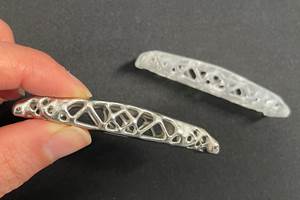Converting to Trivalent Chrome from Hexavalent
Although this requires an initial time and cost investment, Columbia Chemical’s Mark Schario says the benefits of trivalent over hexavalent quickly and increasingly overcome the drawbacks.
Q. I’m getting pressure to eliminate my decorative hexavalent chromium plating process, primarily due to the high cost of waste treatment and regulatory changes. To add to it, we’re having troubles with HCD burning and whitewash, which increases our scrap rate. Can you tell me how the performance of trivalent chromium will compare to hexavalent chromium, and what is needed to make the change?
A. Recent regulations and performance requirements are making the switch from decorative hexavalent chromium plating to trivalent chromium plating a necessity. With hexavalent chromium plating set to be eliminated in the European Union by 2021, many manufacturers, especially global manufacturers, have already specified or are in the process of specifying trivalent chromium on their plans to meet the new regulations. The Occupational Safety and Health Administration and the U.S. Environmental Protection Agency continue to adopt legislation that further justifies switching from hexavalent to trivalent chromium plating. However, much hesitation still exists regarding the switchover to trivalent chromium due to concerns about performance, cost and the overall logistics of the conversion.
From a testing performance standpoint, trivalent chromium has already been used in exterior applications in the trucking industry for the past 30 years. The sulfate/chloride process has shown indefinite electrolyte life, process stability, ease of use and excellent exterior corrosion performance. The field performances of trivalent chromium confirm test results performed by ASTM. The recent testing by the United States Council for Automotive Research has also confirmed these results.
From an operational performance standpoint, throwing power is much better with trivalent chromium. Trivalent chromium is also extremely forgiving with respect to current interruption (this feature eliminates the occurrence of whitewash commonly experienced with hexavalent chromium). The advantages of improved covering power and uniform thickness have eliminated the need to use auxiliary anodes for plating difficult geometries.
When looking to make the transition from hexavalent to trivalent chromium plating, you must first recognize that not all trivalent chromium plating systems are equal. It is best to research the variety of trivalent plating processes available to match the one that will best meet your needs and that of your customers. You will want to evaluate finish color, speed, control, needed equipment and — perhaps most important — the level of service and support you will receive in advance of, during and after the conversion itself as you continue to work with the process.
The first portion of the actual conversion process involves pumping out the hexavalent chromium solution, removing the anodes, taking apart the bussing and removing the tank liner. After that, you cut off the exhaust hood and rinse the remaining ductwork. The tank will need to be leached to remove all traces of hexavalent chromium (this is a critical step). Next, you must rinse the tank and all associated equipment in the area to complete the removal. Then you can install the new liner and then the graphite anodes and copper bussing. Finally, you complete the installation process by installing the air agitation, cooling and heating, and new ductwork. At this point you can fill the tank with water, then acidify to operating pH and use the applicable wetting agent to be used for the process to leach all new equipment. Make up a new plating bath as directed by the manufacturer, and turn on the properly prepared ion exchange. Run your initial lab tests, begin plating and scale up accordingly.
Although there is an initial time and cost investment involved in the conversion from hexavalent chromium to trivalent chromium, the benefits quickly and increasingly overcome the drawbacks. Improved production efficiency, decrease in rejects, substantial savings in wastewater treatment and improvements in employee safety are among the key advantages. Once the transition has been made, many shops quickly realize the positive impact to their operations.
Mark Schario is executive vice president at Columbia Chemical. Visit columbiachemical.com.
Related Content
An Overview of Electroless Nickel Plating
By definition, electroless plating is metal deposition by a controlled chemical reaction.
Read MoreNickel Electroplating
Applications, plating solutions, brighteners, good operating practices and troubleshooting.
Read MorePossibilities From Electroplating 3D Printed Plastic Parts
Adding layers of nickel or copper to 3D printed polymer can impart desired properties such as electrical conductivity, EMI shielding, abrasion resistance and improved strength — approaching and even exceeding 3D printed metal, according to RePliForm.
Read MoreRead Next
The 2024 Ford Mustang: All the Colors Available
Although Chevrolet has announced the end of the Camaro and Dodge is offering “Last Call” editions of the Charger and Challenger, the Ford Mustang is launching to its seventh generation.
Read MorePowder Coating 4.0: Smarter, Faster, More Efficient and Connected
New tools reduce cost and waste, lower manufacturing footprint of powder coating operations.
Read MoreEpisode 42: An Interview with Robin Deal, Hubbard-Hall
Hubbard-Hall wastewater treatment specialist Robin Deal discusses the latest trends in wastewater management.
Read More

























